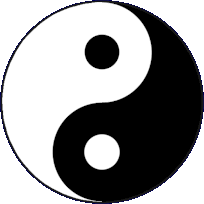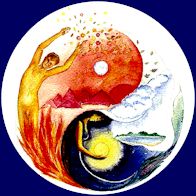Yin and Yang
Concepts and Philosophical Background

Chinese Characters of Yin Yang
 (Chinese
(Chinese  , Pinyin: Tàijí Tú "diagram of supreme ultimate"). The opposites of Yin and Yang are necessary for the formation of an evolving system, and thus a precondition for living organisms.
, Pinyin: Tàijí Tú "diagram of supreme ultimate"). The opposites of Yin and Yang are necessary for the formation of an evolving system, and thus a precondition for living organisms. This thinking way is in some aspects very close to modern science. For example, life with its ever repeating cycles of birth and death is a dynamic system that – following the theory of thermodynamics – can only exits in a non-equilibrium environment, where it is possible to build up – and maintain for a while – ordered structures against the ever growing sea of entropy.
Symbolism and Properties
Yang is associated with high energetic quantities, e.g. movement, outward and upward direction, heat, brightness, stimulation, activity and excitement. Yin has less energetic quantities and is more associated with the physical form of an object. It symbolizes rest, inward and downward direction, cold, darkness. Some characteristics of yin and yang pairs are summarized in the following table.
| Appearance | Yin | Yang |
|---|---|---|
| General properties | negative principle in nature, descending | positive principle in nature, rising |
| Manifestation | substantial, more material, dense | non-substantial, more energy |
| Transformation | grows, produces substance, forms shape | generates, produces energy |
| Action | rest, passive | movement, active |
| Speed | slow | fast |
| Directions | inward, contraction, west (sunset), right | outward, expansion, east (sunrise), left |
| Position | below, north side of a hill, south side of a river, | above, south side of a hill, north side of a river, |
| Location | earth | sky, heaven |
| Time | night | day |
| Shape | flat | round |
| Texture | soft, yielding | hard, solid |
| Light | dark, shady | bright, sunny |
| Temperature | cold | hot |
| Heavenly body | Moon | Sun |
| Physiological functions | inhibitory | excitatory |
| Gender | female | male |
| Others | wet, water; diffuse, turbid | dry, fire; clear |
